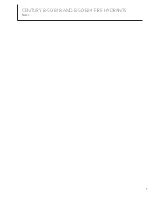
3
INSTALLATION
NOTE: The following information is supplemental
to the AWWA M-17 manual.
When hydrants are received, they should be handled
carefully to avoid damage to the flanges or operating
mechanism. Hydrant valve should be kept closed and
nozzle caps should be in place to prevent entry of
foreign matter prior to installation. Hydrants to be stored
should be protected from the elements if possible.
Hydrant should be located to give minimum hazard to
or from traffic. Place hydrant back from the curb line to
prevent damage to or from overhanging vehicles. On
main thoroughfares place hydrants far enough from
intersections to avoid damage from accidents. Place
hydrants so they are readily visible and accessible.
It is recommended practice to install an auxiliary or
secondary gate valve in the lateral between the hydrant
and the main to permit inspection and repair of hydrant
without shutting down mains.
Before installation of hydrant, clean piping, hydrant
base, and drain ring of hydrant of any foreign material.
It is recommended that a firm footing be used in setting
the hydrant such as stone slabs on undisturbed soil. The
hydrant should also be anchored to oppose the force
due to pressure tending to force the hydrant off the end
of the lateral. Several methods such as strapping,
blocking or restraining type of joint may be used.
If a draining type of hydrant is to be installed, provision
should be made to carry off drainage. An acceptable
method is to excavate around the hydrant to allow
placement of approximately ½ cubic yard of crushed
stone to level about five inches above the drain ring. The
stone should be covered with roofing or tar paper before
backfilling to prevent plugging of the drainage pit.
Both drainage stone and earth fill above the stone
should be tamped to give firm support to the hydrant
barrel.
When first installed, the hydrant should be operated from
the fully-closed to fully-open position and back to make
sure no obstructions are present.
After the hydrant is installed and the line has been
hydrostatically tested, the hydrant should be flushed.
Proper drainage can be verified by placing palm of hand
over nozzle after hydrant has been closed. Drainage rate
should be sufficiently rapid to create a suction.
Nozzle caps should be sufficiently tight to prevent
removal by hand.
OPERATION
Hydrants are designed to be opened and closed
without the use of "cheaters". Excessive leverage may
damage the hydrant, therefore:
• Check direction of opening as marked on the
hydrant cover.
• To open, remove a cap and turn the operating nut
until the valve hits the stop in the opening
direction.
Do not force the hydrant in the
o p e n i n g d i r e c t i o n b e y o n d f u l l o p e n a s
indicated by sudden resistance to turning.
If
water does not flow when the hydrant is open, it is
probably due to a closed valve up stream from the
hydrant.
• To close, slowly turn the operating nut until the
valve closes off the flow.
It is not necessary to
close this style of hydrant with great force.
Once the flow has stopped, loosen the operating
nut in the opening direction to take the strain off
the operating parts of the hydrant and to make it
easier to open the hydrant when needed again.
•
Fire hydrants are not a throttling device and
therefore should be operated in the fully-open
or fully-closed position.
INSPECTION
To assure proper operation of the hydrant, regular
inspections should be carried out. All hydrants should
be inspected twice yearly, in the spring and fall.
When hydrants have been used during freezing
weather, they should be inspected after each use.
Inspection should cover the following items:
External Condition
– Note condition of operating
nuts, caps, flanges, chains and paint.
Valve Leakage
– Use aquaphone to verify that there
is no leakage past hydrant valve.
Barrel or Drain Leakage
– Remove a cap and open
hydrant so barrel fills with water. Replace cap. Open
hydrant fully with nozzle caps in place. Note, if there
is leakage at the nozzles, cap gaskets or barrel
gaskets. Use aqua phone to check leakage through
drains.
CENTURY, B-50-B18 AND B-50-B24 FIRE HYDRANTS
Installation, Operation, Inspection and Maintenance
Содержание B-50-B18
Страница 7: ...7 CENTURY B 50 B18 AND B 50 B24 FIRE HYDRANTS Notes...
Страница 8: ......


























